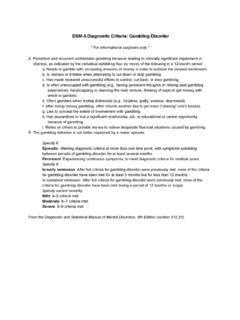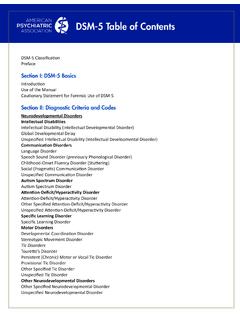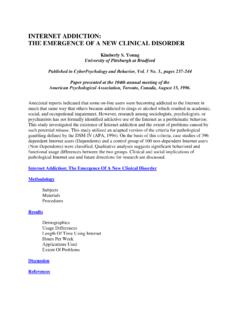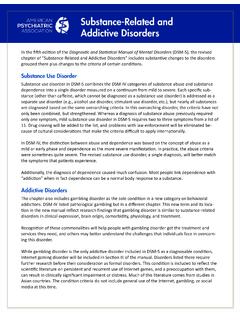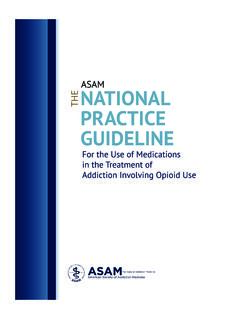Transcription of Borderline Personality Disorder and Treatment Options
1 Borderline Personality Disorder and Treatment Options MELISSA BUDZINSKI, LCSW. VICE PRESIDENT, CLINICAL SERVICES. 2014 Horizon Mental Health Management, LLC. All rights reserved. Objectives 2. Define Borderline Personality (BPD). Educate on the DSM-5 Proposed Diagnostic criteria Identify possible functional impairments Identify Treatment Options (including goal setting, challenges for therapists, and therapeutic interventions to use while in the hospital). Borderline Personality Disorder 3. Borderline Personality Disorder (BPD): Instability of self-image, personal goals, interpersonal relationships and affects, accompanied by impulsivity, risk taking, and/or hostility (DSM-5, 2013).
2 BPD is marked by unstable moods, behavior, and relationships (NIMH, 2014). Demographics 4. According to the National Institute of Mental Health (2014). of adults in the United States have BPD. Usually begins during adolescence or early adulthood 85% of people with BPD also meet the diagnostic criteria for another mental illness. Women: major depression, anxiety disorders or eating disorders , and substance abuse Men: substance abuse or antisocial Personality Disorder Factors in BPD. 5. NIMH reports the combination of the following factors are likely to contribute to BPD: Genetics Environmental factors Brain abnormalities ( emotion regulation or chemicals).
3 DSM-5. 6. DSM-5 Proposed Diagnostic criteria (2013): A. Moderate or greater impairment in Personality functioning, manifested by characteristic difficulties in 2 or more of the following 4 areas: 1. Identity: Markedly impoverished, poorly developed, or unstable self-image 2. Self-direction: Instability in goals, aspirations 3. Empathy: Compromised ability to recognize the feelings and needs of others associated with interpersonal hypersensitivity ( , prone to feel slighted or insulted). 4. Intimacy: Intense, unstable, and conflicted close relationships, marked by mistrust, neediness, and anxious preoccupation with real or imagined abandonment DSM-5.
4 7. B. Four or more of the following 7 pathological Personality traits, at least one of which must be (5) Impulsivity, (6) Risk taking, or (7). Hostility: 1. Emotional liability (an aspect of Negative Affectivity): Unstable emotional experiences and frequent mood changes. 2. Anxiousness (an aspect of Negative Affectivity): Intense feelings of nervousness, tenseness, or panic often in reaction to interpersonal stresses. 3. Separation insecurity (an aspect of Negative Affectivity): Fears of rejection by and/or separation from-significant others.
5 DSM-5. 8. 4. Depressivity (an aspect of Negative Affectivity): Frequent feelings of being down, miserable, and/or hopeless; difficulty recovering from such moods;. thoughts of suicide and suicidal behavior. 5. Impulsivity (an aspect of Disinhibition): Acting on the spur of the moment in response to immediate stimuli. 6. Risk taking (an aspect of Disinhibition): Engagement in dangerous, risky, and potentially self-damaging activities. 7. Hostility (an aspect of Antagonism): Persistent or frequent angry feelings; anger or irritability in response to minor slights and insults.
6 Self-injurious Behavior 9. Self-injurious behavior Suicide and suicide attempts o Approximately 80% of people with BPD have suicidal behaviors (NIMH, 2014). o 4 to 9% commit suicide (NIMH, 2014). Self-harming behaviors ( cutting, burning, hitting, head banging, hair pulling). o Often these individuals do not have a desire to die. However, some of these behaviors may be life threatening. o May be a way to help regulate their emotions, punish themselves, or express their pain. o Do not always see these behaviors as harmful. Functional Impairments 10.
7 Intense and Chaotic Relationships ( I hate you, . don't leave me ). Broken marriages Difficulty maintaining friendships Difficulty managing social activities Inability to maintain employment or school performance Frequent job losses Frequent changes in plans and goals regarding school or career choices Impaired self-image Feelings of hopelessness, worthlessness Functional Impairments 11. Impulsive and risky behavior Reckless driving Unsafe sex Substance abuse/Illicit drugs Gambling sprees Recurring self-injurious behaviors (suicidal behaviors or self- harming behavior).
8 Can have brief psychotic episodes or dissociative symptoms (such as feeling cut off from oneself or losing touch with reality). Treatment Options 12. Psychotherapy (individual and/or group). Cognitive behavioral therapy (CBT). Dialectical behavior therapy (DBT). Schema-focused therapy Medications Family Sessions Treatment Options 13. Cognitive behavioral therapy (CBT). Focuses on identifying and changing core beliefs and/or behaviors that underlie inaccurate perceptions of themselves, others, and problems interacting with others. CBT may help reduce a range of mood and anxiety symptoms and reduce the number of suicidal or self-harming behaviors (Davidson, et al.)
9 , 2006). Treatment Options 14. Dialectical behavior therapy (DBT). Focuses on the concept of mindfulness and awareness of the current situation. DBT teaches skills to control intense emotions, reduces self- destructive behaviors, and improves relationships. This therapy differs from CBT in that it seeks a balance between changing and accepting beliefs and behaviors (McMain, et al., 2007). Treatment Options 15. Schema-focused therapy Focuses on combining elements of CBT with other forms of psychotherapy on reframing schemas or the ways people view themselves.
10 Examines the dysfunctional self-image that affects how people react to their environment, interact with others, and cope with problems or stress (Kellogg, et al., 2006). Treatment Options 16. Medications There are no medications approved by the Food and Drug Administration to treat BPD. Medications may be helpful in managing specific symptoms ( reduce symptoms such as anxiety, depression, or aggression). Psychotherapy and medications are often the used to treat BPD. Family Involvement Include family in Treatment DBT-family skills training (DBT-FST).

